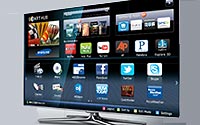Internet-Enabled TV On The Rise
- by Wayne Friedman , August 2, 2012
 Traditional television viewing is still dominant. But IPTV-enabled TV homes -- those with Internet-connected TVs -- continue to climb and look to make an
impact in future years.
Traditional television viewing is still dominant. But IPTV-enabled TV homes -- those with Internet-connected TVs -- continue to climb and look to make an
impact in future years.
Nielsen says IPTV-enabled TV viewing is now 5% of those homes' total TV viewing, as of February 2012. Four months before, it held a 2% share.
As of
February, 10.4% of all TV homes had an IPTV compared to just 4.7% that same month a year prior, according to a recent Nielsen study.
Big-screen regular TV still commands virtually all
viewing -- a 94% share with U.S. viewers watching 35 hours of TV across all screens.
“Internet Protocol TV has grown dramatically over the course of the last year," said Pat
McDonough, senior vice president of insights analysis and policy for Nielsen. "People talk about ‘the TV is dead, or that it’s dying,’ but it doesn’t look like it yet."
Nielsen says non-traditional TV viewing options from Internet-connected sources will continue to grow -- and that unlike other TV-video related technologies, IPTV functions are being built
into televisions.
Other TV-related devices are undergoing changing trends, the company notes. DVRs now appear in 44% of homes -- 80% higher since 2007. But DVD players and older VCRs are
way down.
advertisement
advertisement



The way people want to consume their television viewing is by being able to choose what they want to pay for rather than a large cable subscription with hundreds of channels they don't want. If it were not for HBO/Showtime/Starz and their top-notch TV, there would be a lot more cord cutters. IPTV will soon make it possible to pick and choose quality networks one by one.
Can you clarify what is meant by "IPTV".
In some circles that refers only to video delivered via IP protocol within a subscription MSO package like Verizon FIOS or ATT U-Verse and explicitly does NOT include over-the-top devcies like Connected TV/Smart TV, Roku, XBOX Live, etc.
What definition is this study using?
Thanks